


A Journey on the Ancient Lycian Way in Türkiye
Embark on a virtual journey through time and space, exploring one of the oldest footpaths in the world – the Lycian Way. Situated in the stunning southwest region of Türkiye, this trail traverses ancient ruins, limestone cliffs, lush pine forests, and tranquil beaches, each leg of the journey revealing a new facet of Lycia's rich heritage. Let's delve into the captivating chronicle of the Lycian Way, learn how to prepare for this journey, and explore the major attractions you shouldn't miss along the route.
The History of the Lycian Way
Dating back to ancient times, the Lycian Way echoes the footsteps of the Lycians civilisation as well as others including the Romans later on. The trail takes its name from the ancient Lycian civilization, which thrived in this region around 25 from 15-14th centuries BC to 546 BC. Known for their unique, distinctive rock tombs, the Lycians left an indelible mark on the landscape visitors can explore today.
Preparation for the Journey and Things to Consider
As any experienced hiker knows, preparation is key. The Lycian Way, while beautiful, can be challenging and calls for good physical condition. Hiking boots, a comfortable backpack, and suitable clothing for varying weather conditions are essential. Don't forget sun protection, plenty of water, and nutrient-dense snacks. Maps, a compass, and a reliable guidebook may also be necessary for navigating the terrain even though the path is carefully marked.
Consider the time of year for your journey. Spring (April-June) and autumn (September-November) are considered the best times to walk the Lycian Way, offering mild temperatures and less crowded trails. Always respect the environment and adhere to the 'leave no trace’ principle to preserve the natural and historical integrity of the trail.
Natural Wonders and Ancient Sites to See, and Places to Stay Along the Route
The Lycian Way is not just a hiking trail; it's a living museum, a sprawling gallery of natural and historical sites. Key archaeological sites include the ancient cities of Olympos, Myra, and Patara, where you can marvel at ancient theaters, tombs, and ruins whispering tales from millennia.
One sight you shouldn't miss is the Gelidonya Lighthouse. Perched on the edge of Cape Taşlık in Kumluca, this lighthouse offers breathtaking views of the surrounding landscapes and the Mediterranean Sea. Initially built in 1936 to guide passing ships, the lighthouse is now a popular spot for hikers on the Lycian Way. Standing atop the rocky cliffs and looking out at the endless expanse of blue sea below, one truly feels at the edge of the world. The Gelidonya Lighthouse serves as a reminder of human presence amidst nature's grandeur marks one of the most scenic points of the ancient Lycian Way.
Musa Mountain will enthrall nature lovers with its panoramic views, the pristine Butterfly Valley, and the dramatic cliffs of Kabak. As for accommodations, the trail is sprinkled with charming guesthouses, eco-lodges, and campsites, ensuring a variety of options for every type of traveller.
From the echoes of ancient civilisations to the vibrant tapestry of natural beauty, Lycian Way invites you on a journey through time. Whether you're an avid hiker, a history buff, or a nature lover, there's something to captivate everyone on the Lycian Way. As you prepare for this incredible adventure, remember that the journey is as important as the destination. Each step you take is a step through Türkiye's rich history; each trail you follow is a path that has been tread by centuries of travellers before you.




